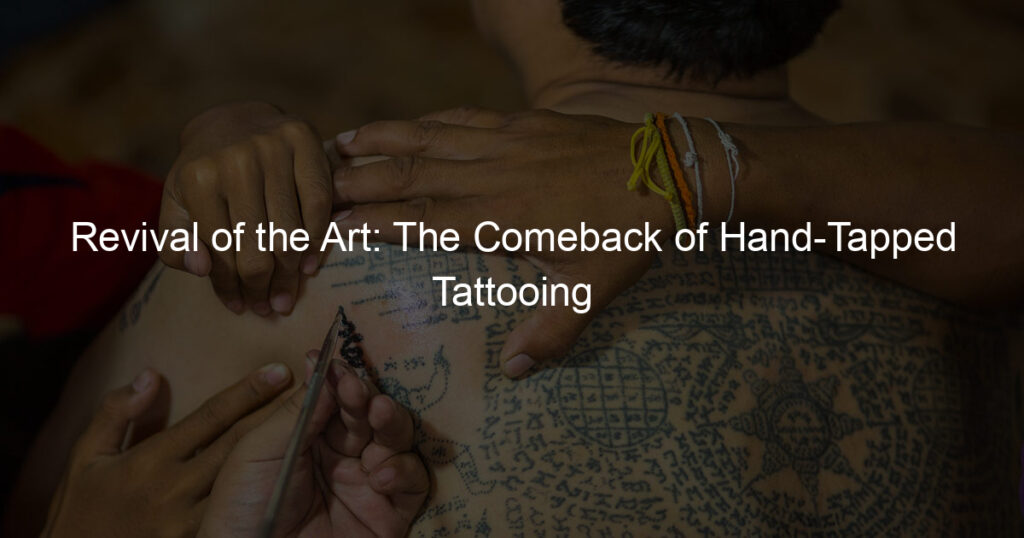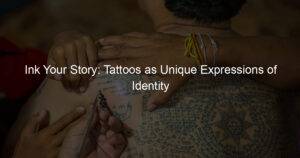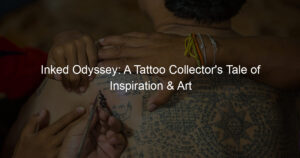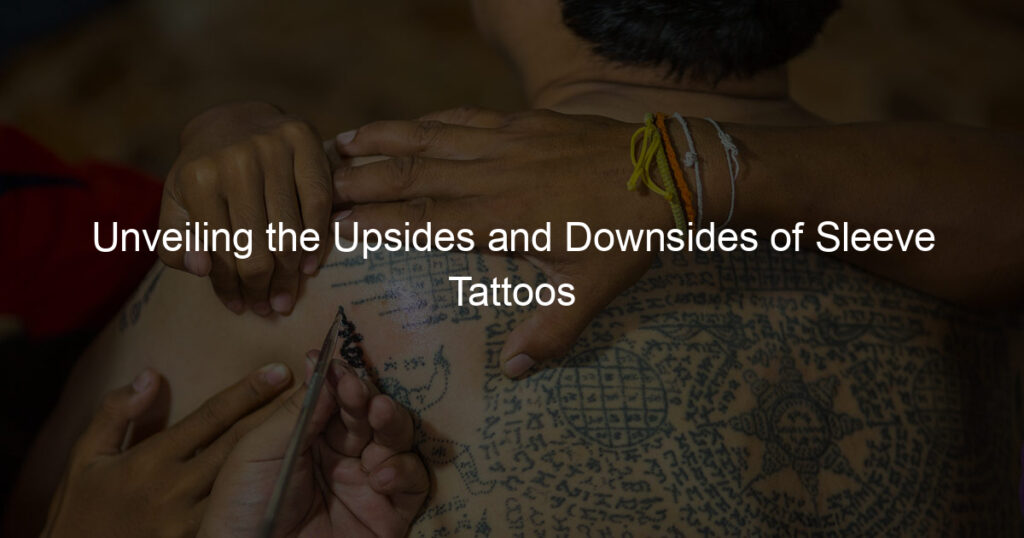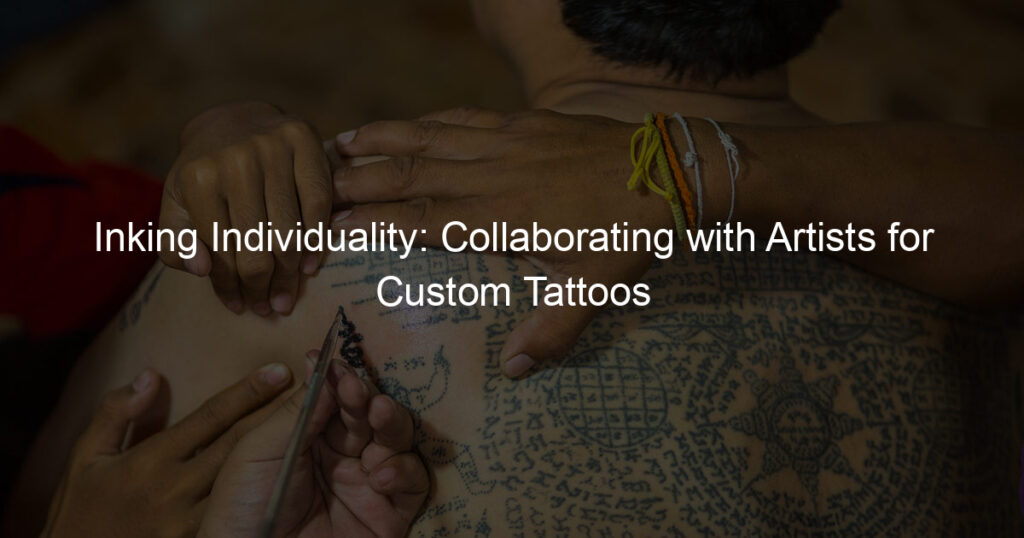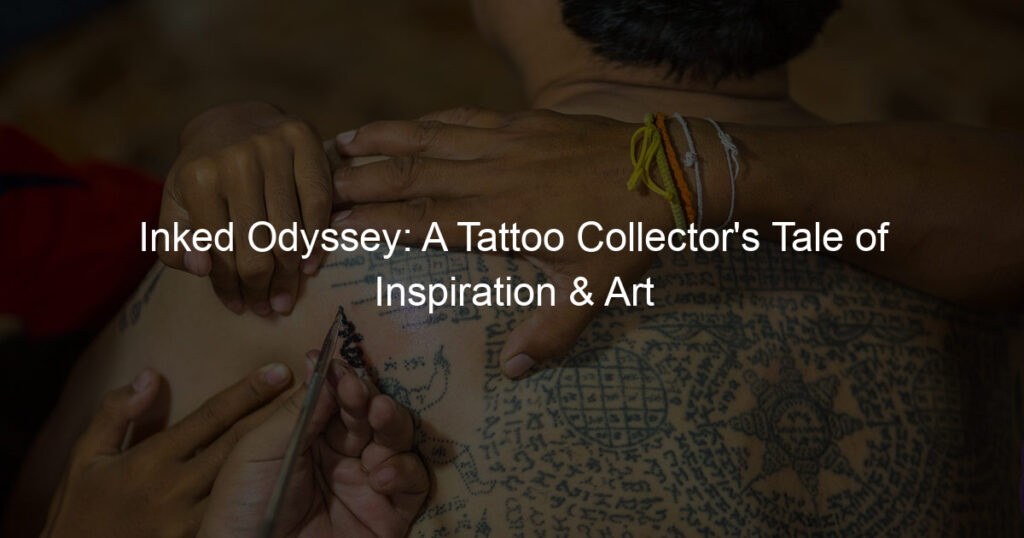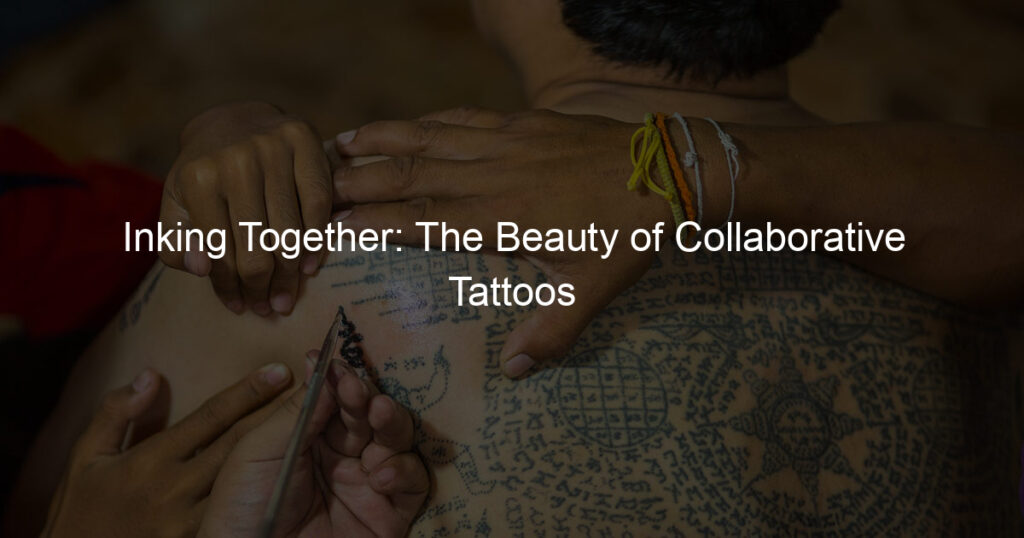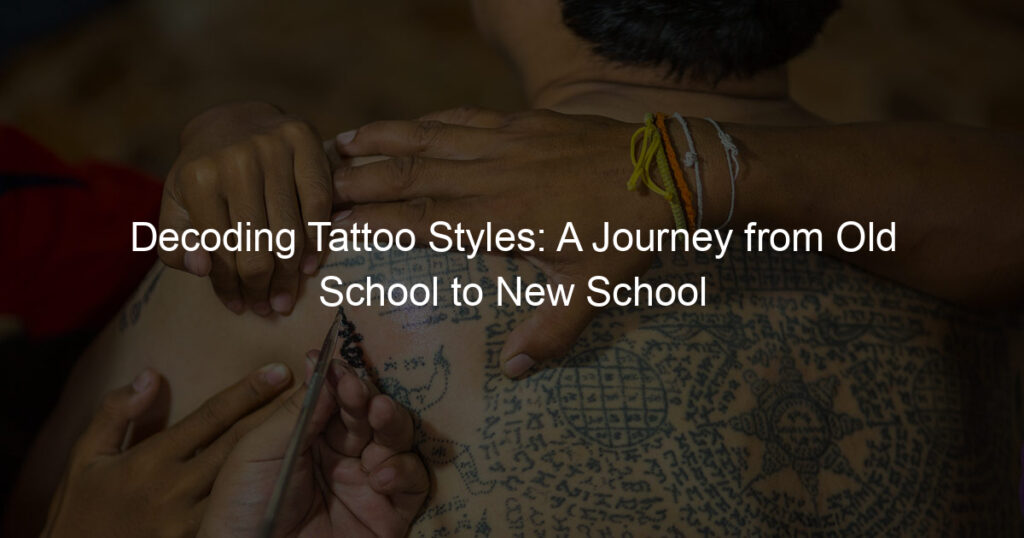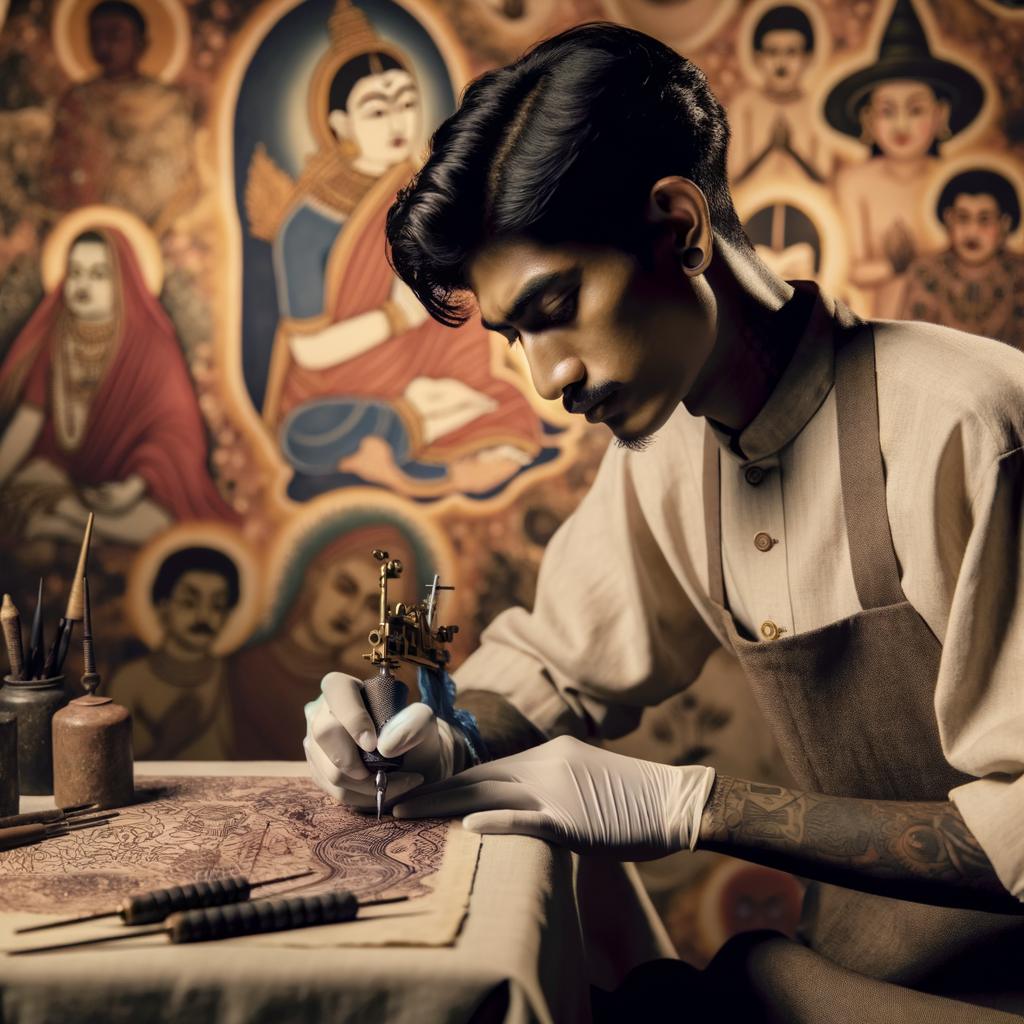
Introduction to Hand-Tapped Tattooing
Hand-tapped tattooing is an ancient art form that has been practiced for centuries. It’s a unique and traditional method of tattooing that has gained popularity in recent years. In this section, we will delve into what hand-tapped tattooing is, its origins, and how it compares to machine tattooing.
Hand-tapped tattooing, also known as traditional tattooing, is a method where the artist uses a stick with a needle attached to it to insert the ink into the skin. Unlike machine tattooing, this process is done entirely by hand, hence the name. The artist taps the stick with the needle into the skin, creating the desired design. This method allows for more control over the depth and spread of the ink, resulting in a unique and often more detailed tattoo.
The art of hand-tapped tattooing dates back thousands of years and is believed to have originated in Southeast Asia. It was a significant part of many cultures, often used for spiritual or ceremonial purposes. For instance, in the Philippines, the ancient practice of ‘batok’ or hand-tapped tattooing was used to signify bravery and accomplishment. While the popularity of hand-tapped tattooing declined with the advent of tattoo machines, it has seen a resurgence in recent years as people seek more traditional and authentic tattoo experiences.
While both hand-tapped and machine tattooing result in permanent body art, there are key differences between the two methods. Hand-tapped tattooing is generally a slower process as each tap of the needle inserts the ink into the skin. This method allows for greater control over the tattoo design but can be more painful due to the slower process. On the other hand, machine tattooing is faster and less painful but may not offer the same level of detail as hand-tapped tattoos. Additionally, hand-tapped tattoos often have a more personal and authentic feel, as the process is more intimate and requires more skill from the artist.
In the following sections, we will explore the resurgence of traditional tattoos, different techniques, cultural methods, and current trends in hand-tapped tattooing.
The Resurgence of Traditional Tattoos
Traditional tattoos, particularly hand-tapped ones, are making a comeback. This resurgence is due to a variety of factors, including the influence of social media and the efforts of dedicated tattoo artists.
-
- Factors contributing to the revival of hand-tapped tattoos
Hand-tapped tattoos are gaining popularity due to their unique aesthetic appeal and cultural significance. The process involves using a needle to manually insert ink into the skin, a technique that dates back thousands of years. This method is seen as more authentic and personal compared to machine-based tattooing. Furthermore, the rise in interest towards ancient cultures and traditions has also played a significant role in the revival of this art form.
-
- Role of social media in the resurgence of traditional tattoos
Social media platforms like Instagram and Pinterest have become powerful tools for tattoo artists to showcase their work and reach a global audience. These platforms allow users to discover different styles and techniques, including traditional hand-tapped tattoos. The visual nature of these platforms makes them ideal for showcasing the intricate designs and patterns of hand-tapped tattoos. Social media has also facilitated the sharing of stories behind these tattoos, adding a layer of depth and meaning that resonates with many people.
-
- Case study: A popular hand-tapped tattoo artist’s journey
One artist who has significantly contributed to the resurgence of traditional tattoos is Kalinga’s Whang-Od Oggay from the Philippines. At over 100 years old, she is considered the last traditional Kalinga tattooist. Her journey began in her early teens, learning the art from her father. Today, she has become a symbol of the country’s cultural heritage and has inspired many young artists to learn and continue the hand-tapped tattoo tradition. Her story, shared widely on social media, has brought global attention to the art of hand-tapped tattoos.
In conclusion, the resurgence of traditional tattoos is a testament to the enduring appeal of this ancient art form. As we move forward, it will be interesting to see how this trend evolves and continues to influence the world of tattooing.
Traditional Tattooing Techniques
When we talk about tattoos, we often think about the modern machines and techniques used today. However, traditional tattooing techniques have a rich history and are still practiced in various parts of the world. Let’s delve into some of these ancient methods.
Ancient Tattooing Techniques
There are several ancient tattooing techniques that have stood the test of time. These techniques are not only a testament to human creativity but also a reflection of cultural values and traditions.
-
Hand-Tapped Tattooing
Hand-tapped tattooing is one of the oldest and most traditional methods. It involves using a stick with a needle attached to it. The artist dips the needle in ink and then taps it into the skin. This method is still used in many cultures around the world, including in Polynesia and the Philippines. It’s a slow process, but many believe it results in more vibrant and long-lasting tattoos.
-
Stick and Poke Tattooing
Stick and poke tattooing, also known as hand poking, is another ancient technique. It’s similar to hand-tapped tattooing, but instead of tapping the needle into the skin, the artist uses a continuous poking motion. This method is slower and often more painful, but it allows for a great deal of precision. It’s a popular method among DIY tattoo artists.
-
Tebori (Japanese Hand Carving)
Tebori, which translates to “hand carving,” is a traditional Japanese tattooing technique. The artist uses a set of needles attached to a wooden handle to carve the design into the skin. This method is known for creating rich, vibrant, and detailed tattoos. It’s a time-consuming process, but many believe the results are worth the effort.
These ancient tattooing techniques have a rich history and continue to influence modern tattooing. They remind us that tattooing is not just about creating beautiful designs on the skin, but also about preserving cultural traditions and values.
Modern Adaptations of Traditional Techniques
As the world evolves, so do our methods and tools. This is true even in the realm of tattooing. Let’s explore how traditional techniques have been adapted to fit our modern world.
-
Modern Hand-Tapped Tattooing Tools
Hand-tapped tattooing is a technique that dates back thousands of years. However, the tools used have seen significant modern adaptations. In the past, artists used tools made from natural materials like bone, wood, and bamboo. Today, many artists use stainless steel rods and needles. These modern tools are easier to clean and maintain, reducing the risk of infection. They also allow for more precision, helping artists create intricate designs with ease.
Traditional Tools Modern Tools Bone, wood, bamboo Stainless steel rods and needles -
Hybrid Techniques: Combining Hand-Tapped and Machine Methods
Another modern adaptation is the combination of hand-tapped and machine methods. This hybrid technique allows artists to merge the best of both worlds. The hand-tapped method offers a unique, organic feel, while the machine provides speed and precision. This combination can result in a unique tattoo that is both traditional and modern.
For example, an artist might use the hand-tapped method for the outline of a design, then switch to a machine for shading and filling in color. This approach allows for a unique blend of styles that can’t be achieved with either method alone.
These modern adaptations of traditional techniques demonstrate the ongoing evolution of tattooing. They allow artists to preserve the essence of ancient methods while embracing the benefits of modern technology.
Cultural Tattooing Methods
As we delve into the world of traditional tattooing, it’s essential to appreciate the diverse methods employed across different cultures. These techniques are not only a form of body art but also a reflection of cultural heritage and identity.
Handmade Tattoo Art in Different Cultures
Hand-tapped tattooing, a method that predates the modern tattoo gun, is still practiced in various cultures worldwide. Let’s explore how this technique is used in Polynesian, Japanese, and Native American cultures.
-
- Hand-Tapped Tattooing in Polynesian Culture
In Polynesian culture, hand-tapped tattooing, also known as ‘tatau’, is a significant rite of passage. The process involves a tattoo artist, or ‘tufuga’, using a set of handmade tools: a ‘tatau’ (a sort of small rake) and a ‘lauhulu’ (a mallet) to tap the ink into the skin. The designs often represent the individual’s social status, personal achievements, and family history.
-
- Hand-Tapped Tattooing in Japanese Culture
Japanese hand-tapped tattooing, known as ‘Tebori’, dates back to the Edo period (1603-1868). The ‘Horishi’ (tattoo artist) uses a ‘Nomi’ (carved handle) with a set of needles attached to the end to puncture the skin and insert the ink. These tattoos, often full-body designs, are rich in symbolism, frequently featuring elements from nature and mythology.
Hand-Tapped Tattooing in Native American Culture
Native American tribes have used hand-tapped tattooing for centuries as a form of self-expression and tribal identity. The process involves a sharp bone or needle to puncture the skin, and soot or natural dyes for the ink. The designs often depict tribal symbols, animals, or celestial bodies, each with its unique meaning.
These cultural tattooing methods are not just about creating beautiful body art. They are a testament to the rich histories and traditions of these cultures, passed down through generations. As we move forward, it’s crucial to respect and preserve these traditional tattooing techniques, as they are an integral part of our global cultural heritage.
Significance and Symbolism of Cultural Tattoos
When we delve into the world of cultural tattoos, we find a rich tapestry of symbolism and significance. Each design carries a unique story, reflecting the heritage and identity of the wearer. Let’s explore the meanings behind popular hand-tapped tattoo designs and the role of tattoos in cultural identity and heritage.
-
- Meanings behind popular hand-tapped tattoo designs
Hand-tapped tattoos are more than just body art. They are a form of expression, a way of communicating personal beliefs, values, and experiences. For instance, in Polynesian culture, the ‘tiki’ design symbolizes protection, while the ‘shark teeth’ design represents guidance and power. In Japanese culture, the ‘koi fish’ is a popular design symbolizing perseverance and determination. Native American hand-tapped tattoos often feature animal totems, each carrying a specific meaning. For example, the ‘bear’ symbolizes strength and courage, while the ‘eagle’ represents freedom and vision.
-
- Role of tattoos in cultural identity and heritage
Tattoos play a crucial role in preserving cultural identity and heritage. They serve as a visual representation of one’s roots, a constant reminder of ancestral lineage and cultural traditions. In many cultures, tattoos are seen as a rite of passage, marking significant milestones in a person’s life. They are a way of expressing pride in one’s cultural heritage and a means of keeping ancient traditions alive. For instance, the Maori people of New Zealand use tattoos, or ‘moko’, as a form of identity, with each design telling a story about the wearer’s family, tribe, and status.
In conclusion, cultural tattoos are a powerful form of self-expression and identity. They carry a wealth of symbolism, each design telling a unique story. Whether it’s a hand-tapped Polynesian ‘tiki’ or a Japanese ‘koi fish’, these tattoos are a testament to the rich cultural heritage of the wearer, a heritage that is proudly worn on the skin for all to see.
Hand-Tapped Tattoo Trends
Hand-tapped tattoos, also known as traditional tattoos, have been gaining popularity in recent years. These tattoos are not only a form of body art, but they also carry cultural significance and history. Let’s delve into the popular styles, designs, and future trends in hand-tapped tattooing.
- Popular hand-tapped tattoo styles and designs
Hand-tapped tattoos come in a variety of styles and designs, each with its own unique charm and significance. Here are some of the most popular ones:
| Style | Description |
|---|---|
| Polynesian | Known for their intricate geometric patterns, these tattoos often tell a story or represent the wearer’s status or achievements. |
| Japanese Irezumi | Featuring mythical creatures, nature elements, and traditional Japanese imagery, these tattoos are rich in symbolism and often cover large areas of the body. |
| Philippine Tribal | These tattoos, known as “batok,” feature geometric patterns and animal motifs. They were traditionally used to signify bravery, status, and accomplishment. |
- Future trends in hand-tapped tattooing
As the appreciation for traditional tattooing techniques grows, so do the trends in hand-tapped tattoos. Here are some future trends to watch out for:
- Personalized Designs: More and more people are opting for designs that are unique to them, telling their own personal stories or representing their individual beliefs and values.
- Combination of Styles: Combining different traditional tattoo styles to create a unique, hybrid design is becoming increasingly popular.
- Colorful Tattoos: While traditional hand-tapped tattoos are typically black, there’s a growing trend of incorporating color into these designs.
In conclusion, hand-tapped tattoos are more than just a trend. They are a celebration of culture, history, and individuality. As we move forward, we can expect to see more innovation and personalization in this art form.
Conclusion: The Future of Hand-Tapped Tattooing
As we reach the end of our journey into the world of hand-tapped tattoos, let’s take a moment to look ahead and envision what the future might hold for this ancient art form.
-
- Continued Resurgence of Traditional Tattooing
Hand-tapped tattooing, a practice deeply rooted in history and culture, is experiencing a resurgence. People are increasingly drawn to the authenticity and unique experience it offers. As more individuals seek out these traditional methods, we can expect to see a continued growth in the popularity of hand-tapped tattoos. The future of this art form is bright, as it continues to captivate and inspire new generations.
-
- Preservation and Innovation in Hand-Tapped Tattooing
While the future of hand-tapped tattooing is promising, it is also crucial to preserve the traditional techniques and cultural significance of this art form. At the same time, innovation is inevitable. Artists are experimenting with new designs and techniques, blending the old with the new. This fusion of preservation and innovation ensures that hand-tapped tattooing will continue to evolve while staying true to its roots.
-
- Final Thoughts on the Art and Culture of Hand-Tapped Tattoos
Hand-tapped tattoos are more than just body art. They are a reflection of identity, culture, and history. As we move forward, it is important to respect and honor the cultural significance of this art form. The future of hand-tapped tattooing lies in the hands of those who appreciate its beauty and understand its deep cultural roots.
In conclusion, the future of hand-tapped tattooing is a vibrant blend of tradition and innovation. As we continue to explore and appreciate this art form, we contribute to its growth and preservation. The resurgence of traditional tattooing is a testament to its enduring appeal. The art of hand-tapped tattoos, steeped in history and culture, will continue to thrive and inspire for generations to come.

